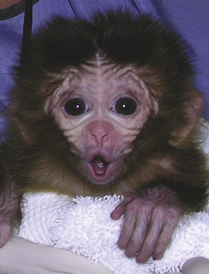
Baby rhesus monkey born during Dr. Zelinski’s study
Over the past decade, women who are about to undergo sterilizing medical treatments have seen a dramatic increase in the number and success rates of methods to preserve their fertility. Women can now cryopreserve their ovarian tissue, eggs, or embryos prior to chemotherapy or radiation. However, all non-experimental forms of fertility preservation currently require surgery. What if women could retain the ability to have biological children without going under the knife? That is what oncofertility researcher Mary Zelinski, PhD, from the Oregon National Primate Research Center , and Jonathan Tilly, Vincent Center for Reproductive Biology, Vincent Department of Obstetrics and Gynecology, Massachusetts General Hospital, examined in a recent paper.
The article is based on the knowledge that cancer therapies cause programmed cell death in a woman’s immature eggs, called oocytes. Dr. Tilly discovered that one factor, sphingosine-1-phosphate (but we’ll call it S1P) prevents this cell death from occurring in mice. However, just because a fertility preservation treatment works in mice doesn’t mean it will work in humans, so Dr. Zelinski took the next step and examined whether S1P and a similarly acting compound, FTY720, also prevents fertility loss in rhesus monkeys. These non-human primates are genetically very close to humans, have similar reproductive organs, and may indicate whether the treatment may also work in humans.
Dr. Zelinski implanted small pumps to continuously deliver S1P or FTY720 directly to the ovaries of the monkeys for one week prior to exposing the ovaries to X-irradiation. She then examined the resumption of menstrual cycles and ovarian health of monkeys treated with or without S1P. Monkeys that did not receive the S1P either never had another menstrual cycle during the study or only had one after the radiation, indicating damage to the ovaries. However, of the monkeys treated with S1P, almost all resumed their cycles within 6 months. FTY720 had an even greater protective effect: all monkeys resumed menstrual cycles within 3 months. In addition, the follicles within the treated monkeys were healthier than those who did not receive SP1 or FTY720.
As FTY720 had the most protective effects on monkey ovaries, Dr. Zelinski next examined whether these females could produce biological offspring after radiation treatment. Excitingly, all females successfully got pregnant and carried their health offspring to term. In addition, adult human ovarian cortical tissues xenografted (or transplanted between two species) into mice also exhibited a reduction in radiation-induced primordial oocyte depletion when preexposed to S1P. This work indicates that scientists are getting closer to preserving fertility and hormonal health for young women with cancer or other diseases requiring radiation treatments. Read the article or watch a news clip on this research.
Are you a cancer survivor? Help oncofertility researchers study and prevent treatment-induced fertility loss by joining the FIRST online fertility registry (registration closed) for cancer survivors!

